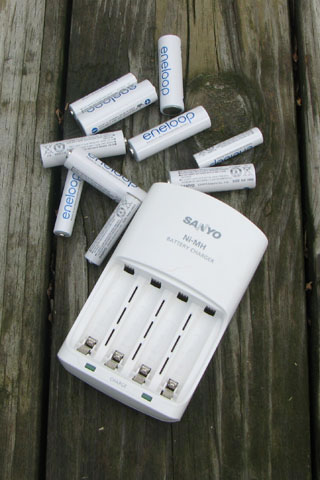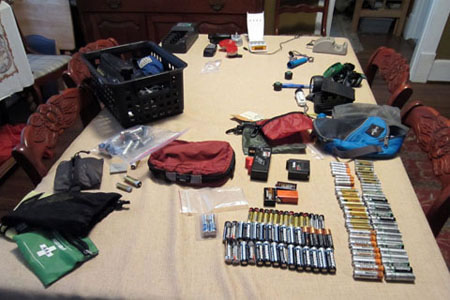| 584 | eneloop | 2012-02-22 |

In today's high tech world, we need energy to make our gadgets work. We agree that the gadgets might not be necessary; but they have become parts of our lives.
Taking the gadgets to the outdoors we need portable power. Our headlamps use AAA batteries. Our lantern uses AAs. The GPS uses AAs, as well as one of our cameras. The iPod, iPhone, other mobile phone, and cameras use proprietary batteries; but most can be recharged by using a small AA battery pack.
There are good non-rechargeable batteries on the market (especially the lithium-ion AAs for cold weather use); but it does not make sense to buy throw away batteries. The regular o' batteries are expensive and contribute to the landfill issues. (If you do use throw away batteries, please dispose of them properly. In Nashville, they have to be taken to a toxic waste disposal center. The rechargeable batteries can be recycled.) The one advantage of the throw aways is that they are reliable. When you take them out of the package and plug them in - they work.
For years we have been using rechargeable batteries for our backcountry needs. Our stack of batteries is a testament of our search to find a good battery. It has not been an easy quest. We have bought name-brand expensive batteries and cheap ones from a specialized battery web site. They all seem to work in the same unreliable fashion. One time they seem like they can power the world and the next time they can't even light an LED bulb. The undependable nature of the rechargeables made us start carrying regular batteries as backups.

In the Spring of 2011, while preparing for our summer trip, we went through all of our old batteries. We tested, drained, and recharged them. Some we even had to charge twice for them to pass the battery test. After a week, we tested them again and many of the batteries had lost their charge. We needed a better battery.
After searching REI and Amazon we decided that there was only one battery to buy, the 'eneloop' by Sanyo. The battery was different than the others. It actually got glowing customer reviews. We purchased a few 'eneloop' batteries last year and were very happy with their dependability. Sanyo advertises that the batteries hold 75% of their charge after three years on the shelf (stored). We did not have a single battery issue while using the 'eneloops'.
A few battery tips ...
Most of the AA and AAA rechargeable batteries only have a three or four year life time. Most electronic stores recycle the batteries.
We try to always drain our batteries before recharging them.
One of our rechargers has a battery drain cycle. I am not sure how well it drains. The charger itself did not work well.
We drain batteries by placing used batteries in an old REI headlamp. The old lamp saps the energy from the batteries in no time. Oh, we would not recommend the headlamp as a light source, but it is the best battery drain that I have tried! (It is a very old lamp.)
We started using a simple battery tester in order to avoid packing duds.
It is important to have a system for where to store the used rechargeable batteries. A plastic bag works fine as a storage bag.
While camping on extended trips, recharging is difficult. We have tried about everything, but the most reliable means of charging is while driving in the car to trailheads, the store, etc.
The batteries Apple sells are rumored to be 'eneloops'.
We still have not found a good, fast battery charger.
The 'eneloop' battery meets our needs. When our headlamp goes out on a long pre-dawn approach, we want a reliable replacement battery. Three-thirty in the morning is not a good time for us to find out that our batteries don't hold a charge for very long.
Happy eneloop trails
REI no longer sells eneloops, if you can't find the batteries, try Amazon.